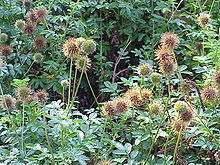| Acaena | |
|---|---|

| |
| Acaena novae-zelandiae foliage and various fruiting stages | |
| Scientific classification | |
| Kingdom: | Plantae |
| Clade: | Tracheophytes |
| Clade: | Angiosperms |
| Clade: | Eudicots |
| Clade: | Rosids |
| Order: | Rosales |
| Family: | Rosaceae |
| Subfamily: | Rosoideae |
| Tribe: | Sanguisorbeae |
| Subtribe: | Sanguisorbinae |
| Genus: | Acaena Mutis ex L.[1] |
| Species | |
|
See text | |
| Synonyms[1] | |
| |
Acaena is a genus of about 60 species of mainly evergreen, creeping herbaceous perennial plants and subshrubs in the family Rosaceae, native mainly to the Southern Hemisphere, notably New Zealand, Australia and South America, but with a few species extending into the Northern Hemisphere, north to Hawaii (A. exigua) and California (A. pinnatifida).[2]
The leaves are alternate, 4–15 centimetres (1.6–5.9 in) long, and pinnate or nearly so, with 7–21 leaflets. The flowers are produced in a tight globose [inflorescence] 1–2 centimetres (0.39–0.79 in) in diameter, with no petals. The fruit is also a dense ball of many seeds; in many (but not all) species the seeds bear a barbed arrowhead point, the seedhead forming a burr which attaches itself to animal fur or feathers for dispersal.
Several Acaena species in New Zealand are known by the common name bidibid. The word is written variously bidi-bidi, biddy-biddy, biddi-biddi, biddi-bid and a number of other variations. These names are the English rendition of the original Māori name of piripiri.[3] The plant is also called the New Zealand burr. The species Acaena microphylla has gained the Royal Horticultural Society's Award of Garden Merit.[4]
- ^ a b "genus Acaena". Germplasm Resources Information Network (GRIN) online database. Retrieved 30 March 2020.
- ^ RHS A-Z encyclopedia of garden plants. United Kingdom: Dorling Kindersley. 2008. p. 1136. ISBN 1405332964.
- ^ Orsman, H. W. (1999). The Dictionary of New Zealand English. Auckland: Oxford University Press.
- ^ RHS Plant Selector Acaena microphylla AGM / RHS Gardening